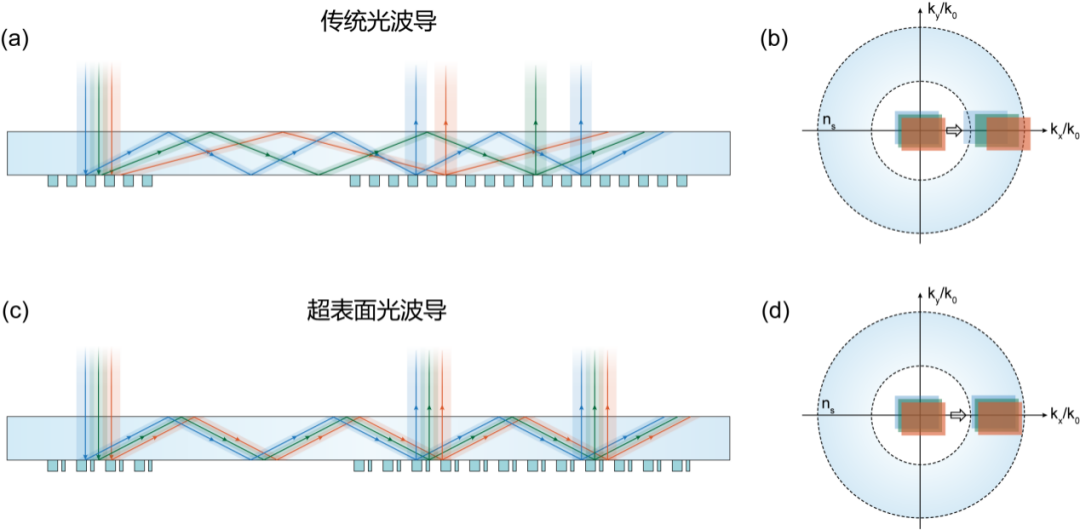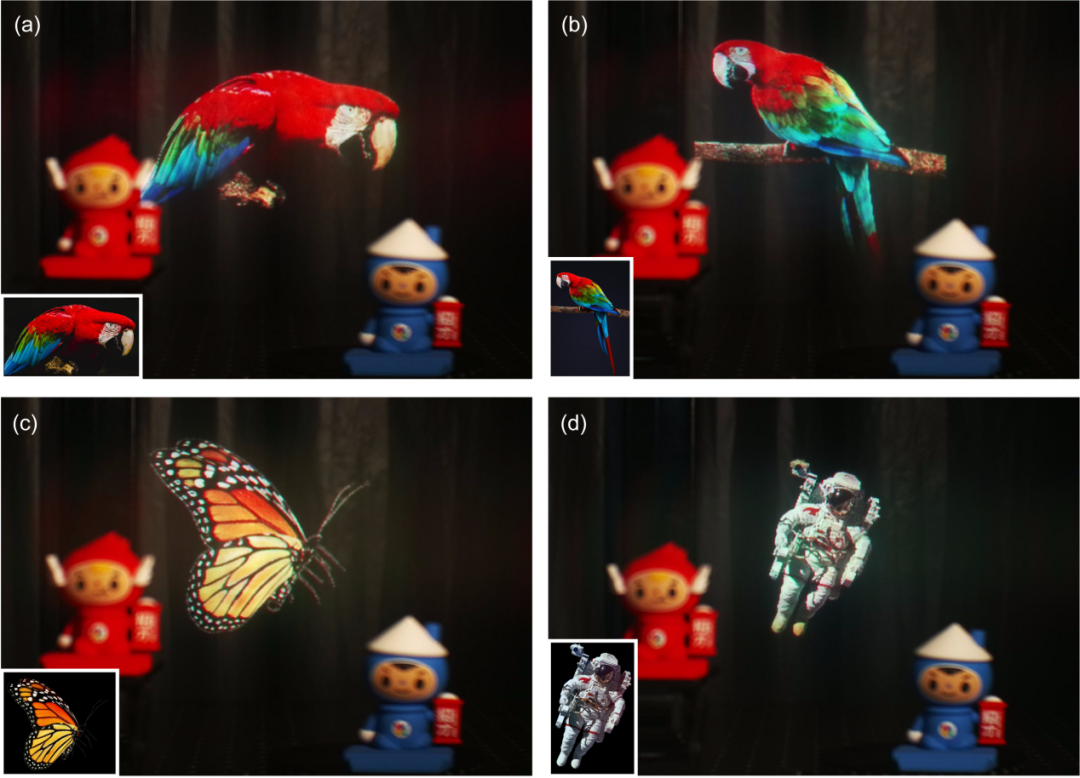11
2025
-
04
Light | Metasurface technology breaks through the color difference bottleneck of AR display
Author:

Figure 1: Schematic diagram of the metasurface waveguide AR display system
Introduction
Augmented Reality Augmented reality (AR) technology is profoundly changing how we interact with the digital world. Its deep integration with artificial intelligence (AI) is ushering in a new era of intelligent human-computer interaction. From industrial manufacturing and smart healthcare to education and training, the combination of AR and AI is redefining work models across various industries, showcasing vast application prospects. To achieve this intelligent experience, the performance of the display system is crucial; clear, natural full-color display is key to ensuring accurate information transmission.
Recently, Professor Sun Xiaowei's team at Southern University of Science and Technology published in 'Light: Science & Applications' significant research findings, proposing an innovative metasurface waveguide technology that fundamentally solves the chromatic aberration problem in AR displays for the first time. This technology breaks through the chromatic aberration bottleneck of traditional coupling devices, providing a new technical path for full-color waveguide displays.
The research results are published under the title: An achromatic metasurface waveguide for augmented reality displays Southern University of Science and Technology is the first completing unit, and Pengcheng Laboratory is the second completing unit. Professor Sun Xiaowei is the corresponding author, Dr. Tian Zhongtao is the first author. The research work is supported by the National Key Research and Development Program, the National Natural Science Foundation of China key project, etc.
The Chromatic Aberration Dilemma in AR Displays
Throughout the history of AR technology, display systems have consistently pursued the unification of "clearer" and "thinner." From the initial reflective mirror displays to the cutting-edge waveguide displays, each technological iteration has progressed towards this goal. Diffractive waveguides, with their ultra-thin characteristics, have become the core technology of AR devices such as HoloLens and Meta Orion. However, this approach also faces a key challenge—image distortion caused by dispersion effects.
Just as sunlight passing through a prism is dispersed into a rainbow, when different colors of light pass through a diffractive waveguide, they are deflected to varying degrees. This dispersion effect not only limits the field of view of the display system but also severely affects the color reproduction of the image. The color distortion problem is particularly noticeable in the peripheral areas of the field of view.

Figure 2: Comparison of traditional waveguides and metasurface waveguides. (a) Traditional waveguides couple light into the waveguide through first-order diffraction, resulting in wavelength-dependent deflection angles; (b) K-vector diagram of a traditional waveguide, with a small overlapping full-color field of view; (c) Metasurface waveguides achieve achromatic light coupling through higher-order diffraction; (d) K-vector diagram of a metasurface waveguide, with a larger full-color field of view.
To address the chromatic aberration problem, the industry mainly uses three-layer waveguides to process red, green, and blue light separately. While this approach is theoretically feasible, it introduces new challenges such as a bulky system, high manufacturing difficulty, and complex alignment. More importantly, even with a multilayer structure, the problem of color uniformity remains difficult to solve fundamentally. Finding the optimal balance between color uniformity, system thinness, and field of view has become a critical challenge that needs to be addressed.
Innovative Breakthroughs in Metasurface Technology
The team at Southern University of Science and Technology proposed a novel solution: using a reverse-designed metasurface coupler and a single-layer high-refractive-index waveguide to successfully solve the chromatic aberration problem. A metasurface is an optical element composed of artificial nanostructures that can precisely control the phase, amplitude, and polarization of light. The research team optimized the geometric structure of the metasurface coupler through a reverse design method, achieving highly consistent coupling efficiency across the RGB wavelength range.
Specifically, the metasurface coupler processes the three primary colors (red, green, and blue) using different diffraction orders (4th, 5th, and 6th order), fundamentally ensuring that light of different wavelengths maintains a consistent deflection angle upon exiting, thereby eliminating chromatic aberration and significantly improving color uniformity. Compared to traditional multilayer waveguide structures, the single-layer design not only significantly simplifies the manufacturing process but also improves the overall performance of the system.

Figure 3: Full-color AR display effect
Outlook: Ushering in a New Era for AR Displays
This groundbreaking research has opened up new avenues for AR display technology. Metasurface waveguide technology not only effectively solves the chromatic aberration problem but also offers several advantages: a single-layer structure reduces manufacturing difficulty, a high-refractive-index design expands the field of view, and optimized coupling efficiency ensures full-color display effects. These characteristics make it promising for next-generation AR devices, signaling a new era for AR display technology.
Paper Information
Tian, Z., Zhu, X., Surman, P.A. et al. An achromatic metasurface waveguide for augmented reality displays. Light Sci Appl 14, 94 (2025).
LATEST NEWS
2025-06-06
Photonic avalanche nanocrystals with >500-order optical nonlinear response
At the forefront of nonlinear optical materials research, photon avalanche (PA), a unique luminescence mechanism occurring in lanthanide-ion-doped systems, exhibits exponential response under continuous laser pumping through an energy positive feedback loop mechanism, thus demonstrating ultra-high-order nonlinear optical behavior far exceeding traditional upconversion processes.
2025-06-05
Ji Xingchen/Su Yikai LPR | 780 nm on-chip integrated high-Q ultra-wideband Fabry-Perot cavity
With the rapid development of applications such as quantum precision measurement, atom manipulation, and narrow linewidth lasers, higher and higher demands are placed on high-performance photonic devices operating in the visible and near-visible wavelength range (especially the 780 nm wavelength corresponding to the rubidium atomic transition).
2025-06-23
Binary optics and metasurface lenses
Bichromatic optics is a subject or an optical technology; the concept of a meta-lens is more inclined to be a device.
2025-06-23
Achromatic diffractive waveguide in AR glasses
AR glasses seem to have developed rapidly in recent years; many believe this is the device most likely to replace mobile phones in the future.

